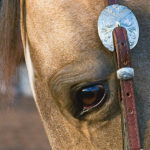Polo wraps warm the poorly insulated muscles, tendons, and ligaments of your performance horse’s lower leg. Once these structures are warmed up, they become limber, and better able to relax and stretch without injury during workouts. Polo wraps also add a cushy layer of protection against external nicks and dings.

Note that polo wraps are too soft and stretchy to actually support your horse’s lower-leg structures. Nor are they suited for securing anything against his leg, such as a light dressing or an ice pack for more than just a few minutes–use a stretchy bandage, such as Vetrap, instead. You need to carefully apply polo wraps to avoid injuring your horse’s tendons; any folds, wrinkles, or bunches could damage them. Here’s my fail-safe method for a smooth wrap.
You’ll need: Four polo wraps (five inches wide or less, made from soft, thick, fleecy fabric–such as Vac’s Deluxe Polo Bandage; 800/327-2395 or 973/345-3355); a ruler; a roll of duct or adhesive tape. Before you begin: Determine stretch. Hold a four-inch length of wrap over the ruler, and stretch it to six inches. That’s the amount of stretch you want to apply, evenly, all the way around your horse’s leg. Otherwise, it’s likely to bunch like a scrunch sock, creating wrinkles.
1. Spiral down. Start at the middle of your horse’s cannon bone (shin), and spiral downward, overlapping each round by 50 percent, until you’ve covered his fetlock joint (ankle) and hooked the ergot (bony growth) at the back. Pay attention to every full wrap, smoothing the material as you go. If a wrinkle appears, eliminate it before you continue.

2. Spiral up. Now wrap upward to the top of your horse’s cannon bone, just below where his leg begins to widen at his carpus (knee) in his forelegs; hock in his hind legs.
3. Secure the wrap. Tape the wrap with an eight-inch spiral of duct or adhesive tape. (The self-hook-and-loop fastener won’t securely hold the wrap.) Repeat on your horse’s other three legs.

For long-term use while your horse is stalled or paddock-confined, reapply the wraps at least every eight hours. Dirt, grit, and seeds can work their way under the material and irritate or injure his skin. Wash the wraps between uses, so they won’t rub grit into your horse’s skin, and to refresh the stretch.
- Machine-wash the wraps, unless otherwise indicated on the washing instructions. (If your horse tends to have irritable skin, use a baby-safe, biodegradable laundry detergent, such as Bio-Kleen, available from Eco-Baby.)
- Machine-dry the wraps, unless otherwise indicated on the label. Avoid over-drying them, which is hard on the fabric. This is better than air-drying, because it maximizes the fabric’s protective fluff.
- Replace your wraps when they lose their stretch, and/or get “lettuce edges.”
This is an expanded version of an article that first appeared in the June 2003 issue of Horse & Rider magazine.





